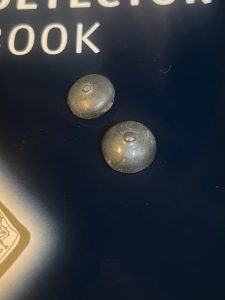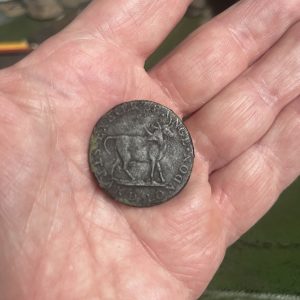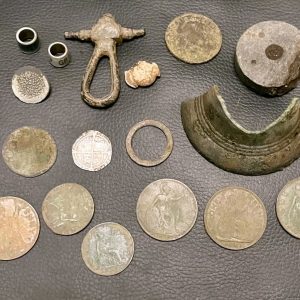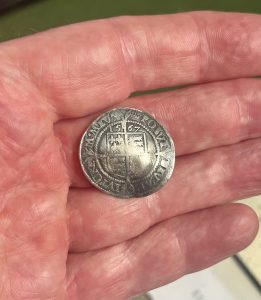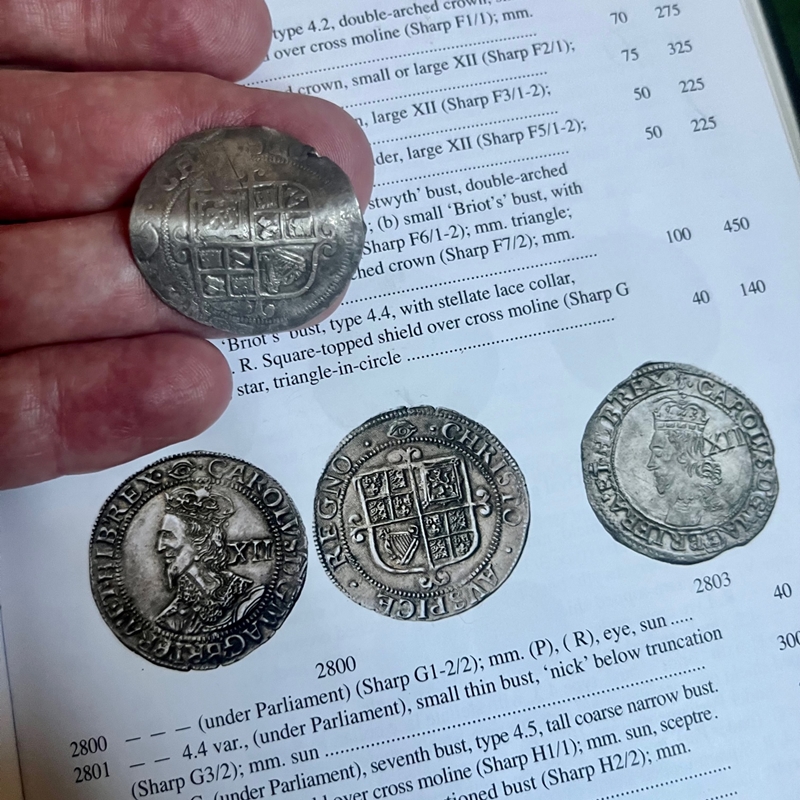
It was a bright sunny spring morning when I headed out to the field between the site of the medieval moated manor house and the old church. I had already found an Edward 1 hammered silver penny on this field but I wanted to cover an area that I had barely touched.
I didn’t have a lot of time but as this permission is less than 15 minutes drive away I could pop back as and when I needed to. As usual I parked in the farmyard and unloaded my metal detecting equipment from the boot of my car.
I don’t use a bag to carry things, I just wear trousers with loads of pockets and attach my digging tool to one side of my belt and my pinpointer to the other side. The only downside to this arrangement is that by the end of the day my trousers are usually sliding down because the pockets are, by then, weighed down with all the usual junk that we detectorists find. Obviously there is far more junk and rubbish than good finds.
Once I was ready I set off on the short walk to this particular field and made my way along to the area that I wanted to start with. I just decided to walk widthways across the field from side to side. It was lovely and bright and sunny, so it didn’t matter much that the signals were few and far between. One side of the field was bordered by a hedge and the other by a stream running alongside a hedge. The previous week there had been sheep in the field with a temporary electric fence to stop them from wandering off, but today it was empty and the electric fence had been switched off.

I just kept going from side to side, but all I was finding was the occasional piece of unidentifiable junk and small pieces of lead. Then the leg ring from a racing pigeon, that probably met a grisly end in the talons of one of the many hawks that I see patrolling the skies in this area.
Then I got a nice sounding signal and dug my usual plug off turf out and scanned the hole and the plug with the detector, it was still in the hole, so out came the pinpointer to work out exactly where it was. It was just a couple of centimetres further down and I gently teased apart the soil and lifted out a ball of soil. Whatever it was, was inside this ‘coin ball’ as we usually call them. I broke it apart with my fingers and was shocked to see resting in my hand the biggest silver hammered coin that I had ever found. Unfortunately it was bent and a bit worn, but I didn’t mind that at all, I just stopped and stared at it for a long time, and then I started to take some photos of it.






I had now been detecting for about 3 hours, I decided to carefully search the area where I found it and then head off home to research exactly what this coin was. I knew from the portrait that it was Charles the 1st, and the XII by the side of the bust told me that it was a shilling, but I wanted to see if I could find out anything else about it.
Once I was home I gently cleaned the dry mud off it and took some more photos and posted them up on a couple of Facebook groups to get a more accurate identification. A specialist hammered coin collectors group came up with this.
It was a Spink 2800, Sharp G2/2 the Eye privy mark dates it to between 12 May 1645 and 10 Nov 1645. Tower (of London) mint under Parliamentary authority. It always amazes me that a coin of this age can be accurately dated to a specific 6 month period!
Yes it is bent, battered and worn but I love it, and love the fact that I rescued it from the depths of a field in Cheshire, where it had been lost for at least a few hundred years and I was the first person to hold it in all that time. That is one of the real wonders of this amazing metal detecting hobby.



